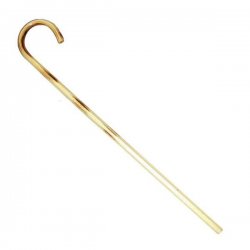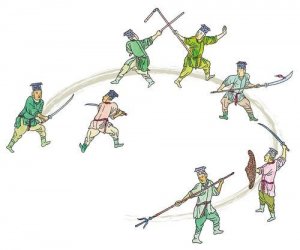This quote is taken from a thread about McDojos. I wanted to break it off and address it as a separate thread, as issues with weapons programs are actually separate from the topic of McDojos.
If you are teaching the use of a weapon, that curriculum should include basic elements of what make the weapon a weapon. Not all weapons are farm implements. Different things make them effective in their use as a weapon. How it is held, gripped, how one guards, and how one strikes are all vitally important.
I've seen weapons programs where a staff is handed to a student and they're told, "you're a black belt. Here's your staff. Do this kata." They learn it, then they're told, "do this kata." This process continued through five kata, which brought the student to second dan grading, after which they started another weapon. Each kata came with an accompanying test that cost as much as a colored belt test, but minus any formal instruction beyond, "you're a black belt. Here's your staff. Do this kata."
What is missing? When that same student began karate/TKD, they were instructed on basics of how to move, guard, parry and strike before they were instructed on kata. But somehow, those same details were left unattended when a stick was put into their hands.
I don't mean to imply that most weapons programs are done in this way; just citing a particularly bad example that I saw first hand. The same school had a guy teaching dao forms he learned from Youtube.
Simply from a safety standpoint, basic instruction should be given. But more importantly, you don't step or stand the same way with a weapon that you do when you practice unarmed. You cannot simply stick a weapon in someone's hand and assume that since he or she is skilled in unarmed combat that they know basics of training with a weapon.
So, if you are going to teach traditional weapon authentically, you should teach the basics of the weapon's use.
If you're teaching XMA, you still need to learn those basics in order to do the kinds of techniques associated with XMA.
If you're teaching theatrical fighting, these basics are still necessary, plus there is a whole host of things specific to theatrical fighting that are not a part of practical weapons training, but which are a must in theatre and cinema.
If you're just having a fun time with weapons and kids using foam swords, then none of that matters all that much.
Also, as I mentioned earlier, all weapons are not farm implements. They each have their own characteristics. And styles using the same weapons often differ substantially in certain areas. Look at a swordman practicing a koryu kenjutsu ryu and compare him to a kendoka. Posture an footwork are very different. Some of the cutting details differ. Look at western swordsmanship and compare Spanish fencing to Italian and French fencing. You'll see very noticable differences between the three.
The cane is also not a farm implement, and several arts have very developed curricula for it.
What learning a weapon may mean personally to a student will vary from student to student. But meaningful instruction in the weapon is objective. It is quanifiable. So yes, I can judge the value of a program. So while I wouldn't judge the value to the student, I can judge the value and merit of the instruction.
Rather than address this point by point, I would like to address the topic of what constitutes a "meaningful weapons program."No meaningful instruction in weapons that were designed based off farm implements to be used in a different era? Just pointing that out, I am well aware that the principles of these weapons can be applied to sometimes readily available everyday items (pool cues, sticks, etc). But is it really your or my place to judge the value of weapons training for other people? I choose to train in the weapons I carry with me or feel I can acquire in most instances. Predominantly my interests are in knives and firearms because I am rarely far from either. But I also enjoy more traditional weapons regardless of their day-to-day self-defense availability. I've seen a lot of schools that have weapons as part of the curriculum, traditional schools, that teach a handful of kata for each weapon, and don't practice them beyond kata. No practice or discussion of their practical application. It never seemed to bother the students. Were I teaching weapons would I want to teach practical applications? Absolutely, but that doesn't necessarily detract from the value of another school. People are enamored with weapons, they want to train in them, as a kid I wanted to train with them and not because I wanted to know how to use them to beat other people up, it was enjoyable. When you watch some of the "extreme" empty-hand and weapons forms that people create for competition that are designed to look good not be deadly do you think that they are wrong for doing so? If they find enjoyment in it, then so be it. Quality is important, but enjoyment is also important. If whatever depth you teach weapons, you are giving quality instruction in what you do teach then what is the problem? Teaching poor quality can be unethical, but we also have to remember that quality is subjective in everything including the martial arts. As far as your last statement, if an instructor adds something to their curriculum that is usually not there but that their students enjoy then this is bad? Back when I went through paramedic school my instructor made all of us learn the full medical school physical assessment that was above and beyond what was required of the curriculum. This made me a worse paramedic, yes? I bit of an extreme example, sorry. But the martial arts students learned a little bit extra about martial arts (even if not to the depth you would prefer or to be experts in the practical applications of that weapon) that they enjoyed learning and this is a qualification for a label?
If you are teaching the use of a weapon, that curriculum should include basic elements of what make the weapon a weapon. Not all weapons are farm implements. Different things make them effective in their use as a weapon. How it is held, gripped, how one guards, and how one strikes are all vitally important.
I've seen weapons programs where a staff is handed to a student and they're told, "you're a black belt. Here's your staff. Do this kata." They learn it, then they're told, "do this kata." This process continued through five kata, which brought the student to second dan grading, after which they started another weapon. Each kata came with an accompanying test that cost as much as a colored belt test, but minus any formal instruction beyond, "you're a black belt. Here's your staff. Do this kata."
What is missing? When that same student began karate/TKD, they were instructed on basics of how to move, guard, parry and strike before they were instructed on kata. But somehow, those same details were left unattended when a stick was put into their hands.
I don't mean to imply that most weapons programs are done in this way; just citing a particularly bad example that I saw first hand. The same school had a guy teaching dao forms he learned from Youtube.
Simply from a safety standpoint, basic instruction should be given. But more importantly, you don't step or stand the same way with a weapon that you do when you practice unarmed. You cannot simply stick a weapon in someone's hand and assume that since he or she is skilled in unarmed combat that they know basics of training with a weapon.
So, if you are going to teach traditional weapon authentically, you should teach the basics of the weapon's use.
If you're teaching XMA, you still need to learn those basics in order to do the kinds of techniques associated with XMA.
If you're teaching theatrical fighting, these basics are still necessary, plus there is a whole host of things specific to theatrical fighting that are not a part of practical weapons training, but which are a must in theatre and cinema.
If you're just having a fun time with weapons and kids using foam swords, then none of that matters all that much.
Also, as I mentioned earlier, all weapons are not farm implements. They each have their own characteristics. And styles using the same weapons often differ substantially in certain areas. Look at a swordman practicing a koryu kenjutsu ryu and compare him to a kendoka. Posture an footwork are very different. Some of the cutting details differ. Look at western swordsmanship and compare Spanish fencing to Italian and French fencing. You'll see very noticable differences between the three.
The cane is also not a farm implement, and several arts have very developed curricula for it.
What learning a weapon may mean personally to a student will vary from student to student. But meaningful instruction in the weapon is objective. It is quanifiable. So yes, I can judge the value of a program. So while I wouldn't judge the value to the student, I can judge the value and merit of the instruction.


